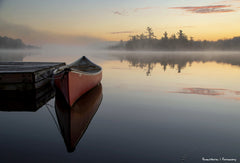
After spending most of 2021 focusing on my starlight series, I have returned to painting rocks and northern lakes again.
I enjoy working in thematic series, and it's energizing to switch things up now and then, but I feel like I am in a very happy place these days. The winter is flying by.

The pair of canoe paintings pictured at the top of this post were inspired by this stunning photo taken at sunrise by Pamela Weston, from her property near Perth, Ontario. She granted permission for me to use the photo as reference for my paintings. (Check out Pamela's wonderful photography here).
Take Me There, varnished watercolour on 11 x 14 inch panel

When I created my painting, I decided to brighten the colours slightly, to emphasize the contrast of blue water and red canoe.
I used Winsor & Newton paints Cobalt, French Ultramarine, New Gamboge, and Permanent Alizarin Crimson to mix all the colours of this scene.
It took many layers of paint (using a wet-in-wet technique) over the course of a week to achieve the smooth blue gradation on the lake water from almost white to almost black. I used 2-brush technique to create the treeline and mist. The canoe and dock were simple to paint on dry paper.
Click here for more details about Take Me There.
Take Me There Again, varnished watercolour on 11 x 14 inch panel
 I so enjoyed the challenges of this subject that I decided to paint a second version with a different colour palette.
I so enjoyed the challenges of this subject that I decided to paint a second version with a different colour palette.
I mixed all the colours I needed from Sennelier paints Phthalocyanine Blue, Sennelier Yellow Deep, and Rose Madder Lake.
This time I found it easier to create the smooth gradation in the water, but the trees and mist were less cooperative. Again, the canoe and dock were easy.
I love to paint scenes that convey an unfolding story, immerse us in the beauty of nature, create a sense of joyful anticipation, hint at a mystery, or capture a precious memory. Every now and then an exceptional painting emerges from my very heart and embodies all these elements. This is just such a painting.
Click here to see more information on Take Me There Again.
Born to Rock, varnished watercolour on 10 x 10 inch panel
 This scene was inspired by rocks and trees near Georgian Bay and Lake Superior.
This scene was inspired by rocks and trees near Georgian Bay and Lake Superior.
I placed the crack in the bedrock to lead the viewer's eye towards the erratic boulder, and then the distant white pine gestures invitingly, to come explore the lake shore.
The Great Lakes region has such wonderful rock formations, born millions of years ago and since then, eroded by wind, water, and ice into the smooth shapes we enjoy today.
 These are the reference photos I used for this painting. They were taken in the Great Lakes region on three different excursions.
These are the reference photos I used for this painting. They were taken in the Great Lakes region on three different excursions.
I used the same trio of paints for this artwork as I did for Take Me There Again.
Click here for more details about Born to Rock.
As the days lengthen towards spring, I continue to work on new paintings of water and stone in my studio. Stay tuned!
If you have comments you wish to share, please do so using the 'Leave a Comment' button at the top of this post.
Subscribe to Karen's Newsletter for exclusive early access to new work, studio news updates, travel tales, painting tips, and notices of upcoming exhibitions.

















































